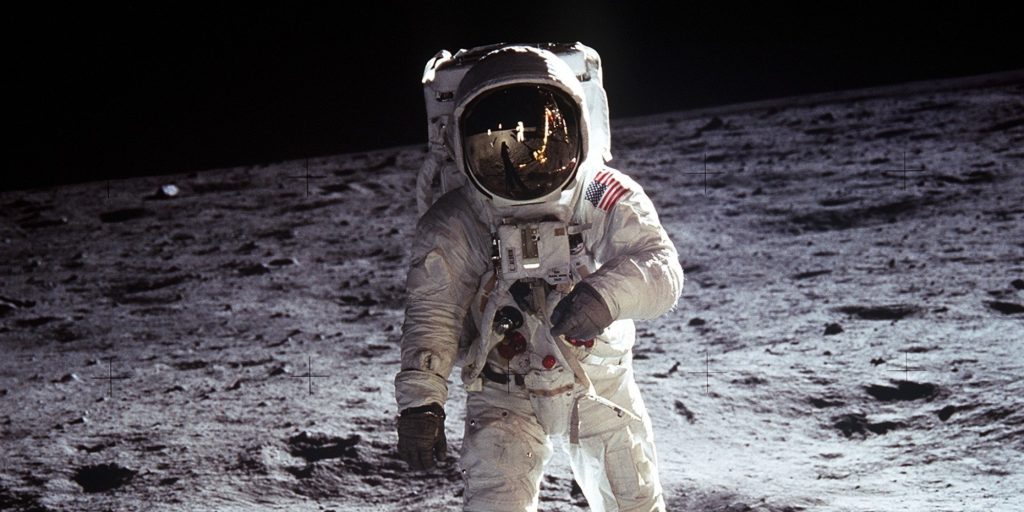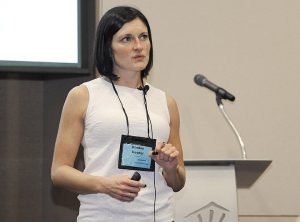The United States is the greatest country on the planet. While we don’t always win (Vietnam War), we do always prevail (back to back World War champions). But our venture to continue to be the dominant super power of the world does not stop at war; it is furthered with the cultivation of our curiosity. When Americans looked up to the moon, they wondered if they would ever go there. They wondered if it was even possible. Little did they know that it was, and that we would be the first to get there.
When the space race began in 1955, the goal was simple: best the Soviet Union in all their endeavors for space supremacy, get a human to the moon, and cure man’s curiosity and will to explore the unknown frontier of space. Through years of trial and error with the Gemini program and Apollo missions at NASA, it would finally be time to give the country what it had asked for. It was time to go to the moon.
Following the immense toll that was taken during World War II, the United States received a technological advantage over the Soviets when it came to various technologies. As it relates to NASA, the capture of German long range ballistic missile technology from the Wehrmacht’s Aggregat program was most important. From the seizure of German scientists and technology through what is known as Project Paperclip, the United States also acquired one of the most notable rocket engineers in the world, Wernher von Braun.1

Wernher would come to serve as director of the Marshall Space flight center. While it is widely known of his capture, participation, and works in American scientific and political life, his case file was never documented or transferred among the other 1,500+ German scientist dossiers by the National Archives and Records Administration (NARA).2 Wernher would become known as the father of space rocketry, space science, and the chief architect of the Saturn V launch vehicle for Apollo 11. Through his genius the United States was going to be able to go to the moon by utilizing the same Wehrmacht military rocketry developed by him for the V-2 guided ballistic missile. It was the downfall of the Nazi regime that led to the dominance of space by the United States.
https://www.youtube.com/watch?v=tv9ITUb340U
We choose to go to the Moon in this decade and do the other things, not because they are easy, but because they are hard…
To get to the moon, NASA was going to need money, and a lot of it. When John F. Kennedy delivered his “we choose to go to the moon” speech, it wasn’t merely a simple gesture to the American people, but rather a rallying call to them. To fund NASA’s expenditures for the upcoming Apollo missions, Kennedy had to assure the American people that this is not a useless endeavor, but one of National Security and the securement of future peace. To fulfill a budget of what Kennedy described as 5.4 billion dollars, people would need to pay “somewhat less than we pay for cigarettes and cigars,” arguing that space expenditures would increase from 40 to 50 cents for every man, woman, and child in the country.3

Even with public support, he still needed to convince politicians that it was within the country’s best interest. Surely, Kennedy thought about this long before this moment. By gaining public support for the Apollo endeavor, in directly putting himself in the line of fire by promoting it, politicians would have no choice but to succumb to the demands of their constituents regardless of what they thought, or be faced with the possibility of not being re-elected. In a joint session of Congress on May 25, 1961, he delivered to them his goal of getting a man on the moon before the end of the decade.4 Finally, the political cogs of bureaucracy were in motion.
Many of Apollo’s initial missions were unmanned. It was important to test the physics of objects and fluids in Zero G in orbital flights and take offs. A shift in payload, fluid, or one small error could cause others and become possibly fatal. Apollo 1 is a sad example of what can happen when there are miscalculations or oversights in safety protocols. During a launch simulation on January 27, 1967, a fire broke out in the cabin of the Apollo 1 spacecraft due to what was believed as an electrical vulnerability, resulting in the death of all three astronauts, Vigil I. “Gus” Grissom, Edward H. White, and Roger B. Chaffee.5

With the death of these astronauts, people began to understand what was really at risk here. It’s not just fighting to win a space race, but it’s also fighting to keep American astronauts safe. Ultimately, when good men have to perish for something that could’ve been avoided, we are only taking steps backward in our progress. To prevent taking steps further backward in the Apollo endeavor, NASA Deputy Administrator Robert Seamans oversaw the establishment of the Apollo 204 Review Board. This review board was to provide answers to a concerned Congress and public as to what exactly happened, ultimately ensuring that the same mistakes would not be made again.
The commander of Apollo 11, Neil Armstrong, was no rookie when it came to space travel. Before being installed as the commander, he had become a seasoned astronaut through participation in the Gemini and Apollo Programs. Although what separated him from most was a distinguished career as an experimental test pilot for NACA, the National Advisory Committee for Aeronautics, which later became what we know and refer to as NASA. With his career and experience in mind, it was only right that Neil Armstrong was to be the commander of Apollo 11.
It was only four missions after Apollo 1 that most notable and historic Apollo 11 spaceflight and landing would take place. Its preceding missions, including the unmanned ones, would bring more and more knowledge about the propulsive maneuvers that would bring us to the moon, and the details of the lunar surface itself, for future landings.6 Finally, it was then on July 16, 1969, that the Saturn V rocket would launch Commander Neil Armstrong, Command Module Pilot Michael Collins, and Lunar Module Pilot Edwin “Buzz” E. Aldrin Jr., into Earth’s orbit. They would then complete one and half orbits to prepare for a Translunar Injection (TLI) burn procedure, a propulsive maneuver that would set them on course for a pathway to the moon to eventually orbit it. History was in the making here. Everything was riding on the success of Apollo 11 and NASA’s endeavors. The Soviets had yet to place a man on the moon and we were on the fast track to defeating them in that endeavor. With no reported errors upon entering Lunar orbit, Apollo 11 was ready to begin its descent stage onto the Lunar surface after a quick visual inspection of the Eagle by Collins. It was after they began their descent that some errors and issues arose, but they were manageable. Not only did Apollo 11 actually overshoot its originally intended landing position by miles to the West, the crew became distracted by their computer system’s executive overflow 1202 and 1201 program errors. Their guidance computer could not complete the task it was given in real time, due to an error in the checklist manual, meaning that those task would have to wait.7 Luckily, NASA’s computer engineers planned for many possibilities, including many computer failures. Its computers recognized such errors, for they had recovery programs to mitigate such issues.
History was in the making here. Everything was riding on the success of Apollo 11 and NASA’s endeavors. The Soviets had yet to place a man on the moon and we were on the fast track to defeating them in that endeavor. With no reported errors upon entering Lunar orbit, Apollo 11 was ready to begin its descent stage onto the Lunar surface after a quick visual inspection of the Eagle by Collins. It was after they began their descent that some errors and issues arose, but they were manageable. Not only did Apollo 11 actually overshoot its originally intended landing position by miles to the West, the crew became distracted by their computer system’s executive overflow 1202 and 1201 program errors. Their guidance computer could not complete the task it was given in real time, due to an error in the checklist manual, meaning that those task would have to wait.7 Luckily, NASA’s computer engineers planned for many possibilities, including many computer failures. Its computers recognized such errors, for they had recovery programs to mitigate such issues.
If the computer hadn’t recognized this problem and taken recovery action, I doubt if Apollo 11 would have been the successful moon landing it was.—Director of Apollo Flight Computer Programming, Margaret H. Hamilton 8
It was through an incredible feat of human engineering and bravery before those famous words were finally uttered: “Houston, Tranquility base here. The Eagle has landed.” The last bit of the phrase is one that is referenced to frequently in pop culture and Hollywood media. Little did Armstrong know how those unrehearsed words would continue to echo beyond Apollo 11’s landing for the rest of time, making its way into the average vocabulary synonymous with that of an arrival.
To go where no man has gone before, Neil Armstrong became the embodiment of the American spirit. Although we know that many men and women worked countless hours to make it happen, the names that are remembered are those who embody bravery, honor, and intellect altogether. Neil Armstrong is the name we know and will never forget, for allowing us to say we did get on the Moon first. We the United States did it first.
- Annie Jacobson, Operation Paperclip: The Secret Intelligence Program to Bring Nazi Scientists to America (New York: Little, Brown and Company, 2014), Prologue-ix. ↵
- National Archives and Records Administration, “Foreign Scientist Case Files 1945-1958 (Entry A1-1B)” last modified October 11, 2016. https://www.archives.gov/iwg/declassified-records/rg-330-defense-secretary. ↵
- John Kennedy, John F. Kennedy Moon Speech – Rice Stadium, https://er.jsc.nasa.gov/seh/ricetalk.htm ↵
- Steve Garber, “The Decision to Go to the Moon: President John F. Kennedy’s May 25, 1961 Speech before a Joint Session of Congress,” NASA History Office, Updated October 29, 2013, https://history.nasa.gov/moondec.html. ↵
- Richard W. Orloff, Apollo by the Numbers: A Statistical Reference (NASA History Division, Office of Policy and Plans: Washington D.C, 2004), https://history.nasa.gov/SP-4029/SP-4029.htm. ↵
- NASA, Apollo 11 Lunar Landing Mission (Washington D.C: NASA, 1969), https://www.hq.nasa.gov/alsj/a11/A11_PressKit.pdf. ↵
- Michael Collins and Edwin E. Aldrin, Jr., A Yellow Caution Light (NASA: Washington D.C, 1975), https://history.nasa.gov/SP-350/ch-11-4.html. ↵
- Margaret H. Hamilton, “Computer Got Loaded,” Datamation, March 1971, 1. ↵



52 comments
Danielle Rangel
This was an interesting article to read! I liked the structure of the article itself because it made it easier to read. I think it is interesting how a “competition” between the US and the USSR sparked many technological advancements that were able to get man to space and the moon. It is really interesting to see how fast both countries worked to best the other in the space race. Overall this was a great article explaining how man got the moon and how the US “bested” the USSR.
Madison Magaro
This was a great article that described the race to space. I enjoyed reading this article and I think that it is crazy we were able to make it into space with how technology was back then. Everyone that was apart planning the launch to the moon had so much dedication and will power to ensure that they would get there.
Andrea Tapia
I still can’t believe till today that Neil Armstrong was the first man to land on the moon with the many amazing astronauts that followed along. Great article and being able to explained what happened during Apollo 11 and that Kennedy was involved in this amazing experienced. To be the voice and allow a miracle to happen. That we only had to contribute 50 cents so that we can get a budget of 5.4 billion dollars is insane. Neil Armstrong name will always be remembered. We need to be able to learn more about space and understand how its not an easy mission to accomplish, but we can do the impossible. This is what makes us so strong and brave to put our lives at risk for a better future to live in and discover more.
Olivia Gray
This is such a well written article and very interesting to read.I really enjoyed reading about the Space Race and the major impact it had on history. I remember when I was younger I was so interested in learning about space and was so fascinated by it. I didn’t fully realize how much JFK impacted this movement .The picture you chose really help tell the story as well.
Karlo Collazo
When in High School, I did a project on JFK and how he contributed to the US in his short term as president. I always found it interesting how confident he was in his goal to go to the moon. While the US was essentially losing the Space Race, for JFK to make that speech was not only empowering but motivating, and it certainly did for the many engineers at NASA. I thought the article did a good job depicting the space race and the story surrounding it.
Ruben Becerril
The article name was able to capture my attention and the content retained it. Each paragraph linked to the next with smooth transitions. I really liked the diagram of the Earth and moon at the end, I was able to visualize what route the rocketship took. Many new terms were used but your explanations made it easy for me to understand what they meant.
Dylan Miller
As a kid, I’ve loved to look up into space and think about how to get up there, I used to watch movies about space, read up on it, and watch videos about it. But somehow I missed the space race, so reading up on it now is extremely fascinating! The idea of getting to the moon first is so exhilarating! Even though it was extremely expensive, I can’t image the amount of enjoyment and inspiration that the race caused!
Marcus Saldana
The space race to me is just another reason to love america. It is crazy how they were able to go to the moon with the technology they had at the time with computers being more big than a person. It shows how persistent they were to make their dreams a reality. Neil Armstrong would be a goat in my books but what he said about Elon makes him not an american hero in my books. Great article about space race great video included mid way.
Andrew Gonzales
The Spacerace is one of the most important things to ever happen in our history. The people and dedication that made it all possible is truly something to remember adding the fact that phones weren’t even a thing! Along with so much technology but it goes to show if we are dedicated and willing we can do anything no as Americans but as a whole.
Christopher Hohman
Nice article. It is always interesting to read about post war history. The space race especially is an interesting topic to cover. It took great ingenuity and determination to beat the Soviets to the moon especially because they had a bit of an edge over us in terms of the development of their space program. JFK’s speech is one of the greatest speeches ever made by a U.S president. He was indeed right when he said that we do these things not because they are easy but because they are hard. That is what makes us humans so special